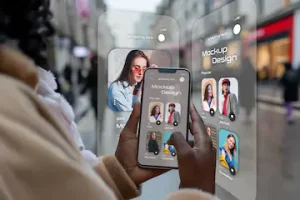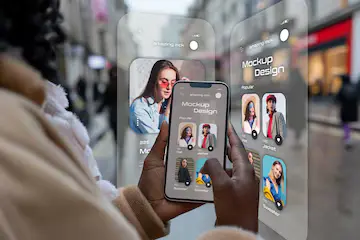Integrating Augmented Reality (AR) into advertising strategies can significantly enhance customer engagement by providing immersive and interactive experiences. Here’s how businesses can make the most of AR advertising:

1. Enhancing Product Visualization
To begin with, AR enables customers to experience products virtually before making a purchase. For instance, IKEA’s AR app allows users to place virtual furniture in their homes, while fashion brands such as Gucci and Nike offer AR-powered virtual try-ons for clothing and accessories.
2. Elevating Print and Outdoor Advertising
In addition to digital campaigns, AR can bring traditional advertising to life. By scanning a QR code on billboards or magazines, consumers can access animated content, product demonstrations, or interactive brand stories, making advertisements far more engaging.
3. Boosting Social Media Engagement with AR Filters
Furthermore, AR filters and lenses on platforms like Instagram, Snapchat, and TikTok help brands connect with audiences in a fun and engaging way. For example, companies like Coca-Cola and McDonald’s have successfully launched branded AR face filters to promote their campaigns.
4. Gamifying the Advertising Experience
Another compelling way to leverage AR is through interactive contests and gamification. By introducing AR-based scavenger hunts or location-based rewards, brands can encourage customers to actively participate in their campaigns, similar to how Pokémon GO created an immersive brand experience.
5. Utilizing Location-Based AR Ads
Beyond gamification, businesses can also take advantage of geotargeted AR experiences. For example, retailers can create AR pop-up stores in high-traffic areas, allowing customers to interact with products in an innovative way.
6. Bringing Packaging to Life with AR
Moreover, product packaging can be made more dynamic with AR. By scanning labels, customers can unlock engaging content, such as behind-the-scenes brand stories. A great example of this is wine brands using AR to animate their labels, adding a storytelling element to their products.
7. Creating Virtual Showrooms and Experiences
Similarly, industries like automotive and real estate are using AR to replace traditional showrooms with virtual alternatives. Automakers such as BMW and Audi showcase new car models using AR, while real estate companies offer virtual property tours, allowing customers to explore homes remotely.
8. Transforming E-Commerce with AR Shopping
At the same time, AR enhances the online shopping experience by offering 3D product previews. Brands like Sephora and L’Oréal, for instance, enable customers to virtually try on makeup, helping them make more informed purchasing decisions.
9. Elevating Live Events with AR Integration
Likewise, AR can transform live events and concerts into immersive brand experiences. A notable example is Pepsi’s AR campaign at a London bus stop, where passersby witnessed virtual UFOs and tigers appearing on the street, making the advertisement both memorable and entertaining.
10. Personalizing Ads with AI and AR
Finally, AI-driven AR ads can tailor experiences to individual users, ensuring more personalized interactions. For example, virtual AI assistants can recommend products based on customer preferences, creating a highly customized shopping experience.
In summary, AR advertising seamlessly blends digital and real-world interactions, making campaigns more engaging, memorable, and shareable. Thanks to advancements such as WebAR, businesses can now integrate AR experiences without requiring app downloads. By investing in AR-driven advertising, brands can boost customer engagement, enhance conversion rates, and strengthen brand loyalty.






Leave feedback about this